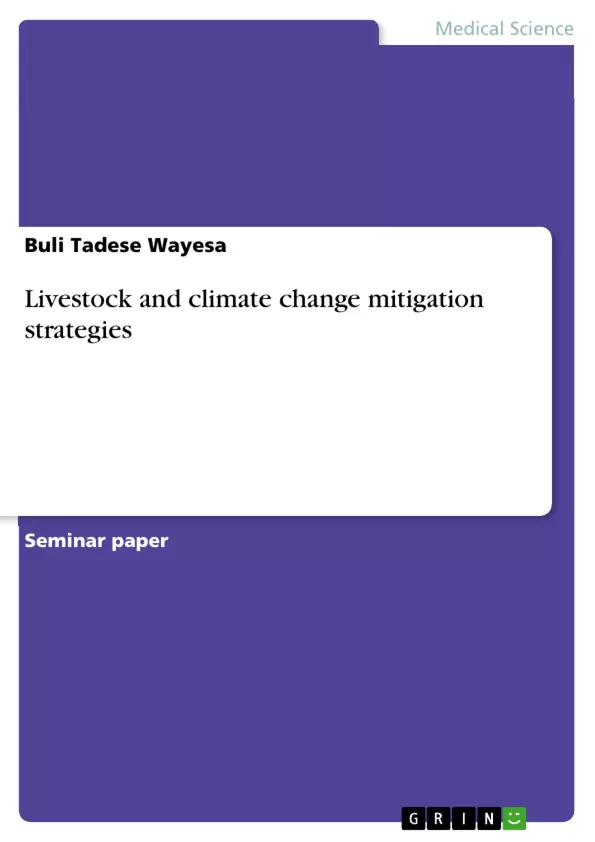The objective of this review is to point out that the global dialog on reducing greenhouse gas emissions in animal agriculture has, thus far, not adequately considered animal welfare in proposed climate change mitigation strategies. Many suggested approaches for reducing emissions, most of which could generally be described as calls for the intensification of production, can have substantial effects on the animals. Climate change is seen as a major threat to the survival of many species, ecosystems and the sustainability of livestock production systems in many parts of the world. As per estimates, about 12.5% of total emissions of greenhouse gases are related to livestock production .This contribution is even higher (18%) when the deforestation related to the expansion of livestock production area is also considered to meet the growing demand of animal products. Livestock contributes about 9% of total carbon dioxide production emissions, 37% of methane, and 64% of nitrous oxide emissions throughout production process. There is an urgent need to integrate these other sustainability measures into GHG mitigation assessments. Mitigation in reducing emissions can be achieved in different ways related to animal feeding and management, manure collection, storage, improved animal waste management through energy (biogas) recovery, and management of crops fed to the livestock by bringing more drastic changes of the whole production system. A number of techniques exist to reduce methane emissions from enteric fermentation from ruminants. Improving the genetic potential of animals through planned cross-breeding or selection within a breed, and achieving this genetic potential through proper nutrition and improvements in reproductive efficiency, animal health and reproductive lifespan are effective and recommended approaches for improving animal productivity and reducing GHG emissions per unit of product. There are several factors which need to be considered for selection of best options for methane emission reduction: these include climate, economic, technical and material resources, existing manure management practices, regulatory requirements etc. Generally the methane mitigation strategies can be grouped under three broader headings viz., manage mental, nutritional and advanced biotechnological strategies.
Inhaltsverzeichnis (Table of Contents)
- 1) INTRODUCTION
- Objective
- 2) Literature Review
- 2.1. Livestock and climate change
- 2.2. Livestock impact and mitigation measures
- 2.3. Sequestering carbon and mitigating carbon emissions...
- 2.4. Methane mitigation strategies.
- 2.4.1. Enteric methane mitigation through nutrition
- 2.5. Mitigation through manure management
- 2.6. Animal genetics Improvement
- 2.7. Animal health and longevity
- 3) CONCLUSION
- 4) RECOMENDETION
- 5) REFERANCE
Zielsetzung und Themenschwerpunkte (Objectives and Key Themes)
This paper aims to explore the complex relationship between livestock production and climate change, focusing on strategies for mitigating the negative environmental impact of livestock. The paper examines the role of livestock in greenhouse gas emissions and discusses various mitigation measures that can be implemented to reduce this impact.
- Livestock's contribution to greenhouse gas emissions, particularly methane
- Mitigation strategies for reducing methane emissions from livestock
- The role of nutrition, manure management, and animal genetics in mitigating emissions
- The importance of animal health and longevity in sustainable livestock production
- The potential of sequestering carbon and mitigating carbon emissions through livestock practices
Zusammenfassung der Kapitel (Chapter Summaries)
The paper begins with an introduction that establishes the context for exploring the link between livestock and climate change. It then delves into a comprehensive literature review, examining the impact of livestock on the environment and exploring various mitigation measures. The review covers topics such as livestock's contribution to greenhouse gas emissions, particularly methane, and discusses strategies for reducing these emissions through nutritional interventions, manure management, and genetic improvements. The chapter concludes with an overview of the importance of animal health and longevity in achieving sustainable livestock production.
Schlüsselwörter (Keywords)
Livestock, climate change, greenhouse gas emissions, methane, mitigation strategies, nutrition, manure management, animal genetics, animal health, longevity, carbon sequestration, sustainable livestock production.
- Quote paper
- Msc.Student Buli Tadese Wayesa (Author), 2017, Livestock and climate change mitigation strategies, Munich, GRIN Verlag, https://www.grin.com/document/377520



